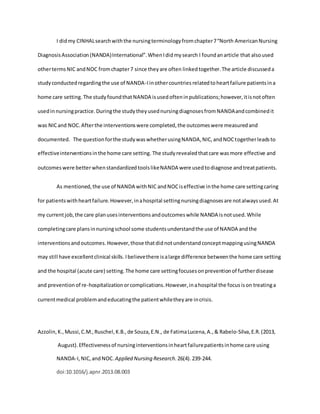Report
Share

Recommended
More Related Content
Similar to Wk 4 CINHAL search
Similar to Wk 4 CINHAL search (20)
19Table of ContentsAPN Capstone Portfolio Part 23Exempl

19Table of ContentsAPN Capstone Portfolio Part 23Exempl
Bioinformatics practice questions Protein fragment PNLPDCDMES WLNA

Bioinformatics practice questions Protein fragment PNLPDCDMES WLNA
The use of pulsed radiofrequency for the treatment of pudendal neuralgia a c...

The use of pulsed radiofrequency for the treatment of pudendal neuralgia a c...
Obtaining Patient Information and Anxiety in Novice Nursing Students ,Article...

Obtaining Patient Information and Anxiety in Novice Nursing Students ,Article...
NURS 4030 Capella University Evidence to Develop Care Practices Discussion.docx

NURS 4030 Capella University Evidence to Develop Care Practices Discussion.docx
Day..week3 disc 3Top of Form 1Role of the Advanced Practice Nu.docx

Day..week3 disc 3Top of Form 1Role of the Advanced Practice Nu.docx
NRS 493 GCU Wk 6 Negative Pressure Wound Therapy Ethical.pdf

NRS 493 GCU Wk 6 Negative Pressure Wound Therapy Ethical.pdf
Week 2 The Clinical Question77 unread replies.2525 replies..docx

Week 2 The Clinical Question77 unread replies.2525 replies..docx
Dr. Ameri and class,After reflecting over the course of Advanced.docx

Dr. Ameri and class,After reflecting over the course of Advanced.docx
Wk 4 CINHAL search
- 1. I did my CINHAL search with the nursing terminology from chapter 7 “North American Nursing Diagnosis Association (NANDA) International”. When I did my search I found an article that also used other terms NIC and NOC from chapter 7 since they are often linked together. The article discussed a study conducted regarding the use of NANDA-I in other countries related to heart failure patients in a home care setting. The study found that NANDA is used often in publications; however, it is not often used in nursing practice. During the study they used nursing diagnoses from NANDA and combined it was NIC and NOC. After the interventions were completed, the outcomes were measured and documented. The question for the study was whether using NANDA, NIC, and NOC together leads to effective interventions in the home care setting. The study revealed that care was more effective and outcomes were better when standardized tools like NANDA were used to diagnose and treat patients. As mentioned, the use of NANDA with NIC and NOC is effective in the home care setting caring for patients with heart failure. However, in a hospital setting nursing diagnoses are not always used. At my current job, the care plan uses interventions and outcomes while NANDA is not used. While completing care plans in nursing school some students understand the use of NANDA and the interventions and outcomes. However, those that did not understand concept mapping using NANDA may still have excellent clinical skills. I believe there is a large difference between the home care setting and the hospital (acute care) setting. The home care setting focuses on prevention of further disease and prevention of re-hospitalization or complications. However, in a hospital the focus is on treating a current medical problem and educating the patient while they are in crisis. Azzolin, K., Mussi, C.M., Ruschel, K.B., de Souza, E.N., de Fatima Lucena, A., & Rabelo-Silva, E.R. (2013, August). Effectiveness of nursing interventions in heart failure patients in home care using NANDA-I, NIC, and NOC. Applied Nursing Research. 26(4). 239-244. doi:10.1016/j.apnr.2013.08.003